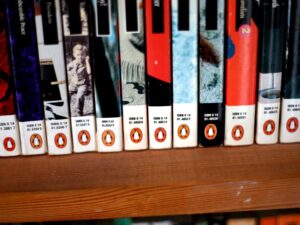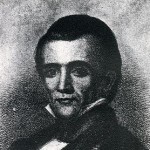library
 Before the internet, people who wanted or needed to research a subject, for personal use or for schoolwork, had to go to the library, because they usually didn’t have the tools to research things at home, with the possible exception of a set of encyclopedias. I think many of us have had a physical set of encyclopedias, but those books had their own set of problems…the greatest being that they quickly became outdated. Of course, the internet has its own set of problems too…the greatest being misinformation and outright lies.
Before the internet, people who wanted or needed to research a subject, for personal use or for schoolwork, had to go to the library, because they usually didn’t have the tools to research things at home, with the possible exception of a set of encyclopedias. I think many of us have had a physical set of encyclopedias, but those books had their own set of problems…the greatest being that they quickly became outdated. Of course, the internet has its own set of problems too…the greatest being misinformation and outright lies.
All that aside, in the not-so-distant past, since it was still in my lifetime, research was done in the library, which is why so many schools had one of their own, at least in junior high and high school. The students, armed with a research subject went to the library and began their search. Basically, the library was the “internet” of the past. Your search would often begin with the card catalog. This was a large cabinet with very small drawers filled with cards with holes in the bottom that were attached to a rod in the bottom of the drawer. The cards were arranged alphabetically so they could be easily researched, but if the subject had a lot of information out there, that did not mean that the search would be a quick one.
Once the desired information was located, the researcher would use a slip of paper (usually provided by the  library) to write down the information the card gave as to the location of the book that housed the detailed information that had been summarized on the card. The card always contained a number such as 746.43, which was really a code for the location of the book needed by the researcher. In this case, the 7 stands for the classification…Art. The first 4 stands for the division…drawings/decorative arts. The 6 stands for the section…textile arts. The numbers following the decimal stand for classification within the section…type of textile. Armed with this information, the researcher was able to go to the section of the library that holds that classification of book and locate their book, or just as often they could go to the librarian and receive help to find their book. Of course, the biggest problem with this type of research is that the book might very likely be checked out already, especially if it was a popular subject. If the book wasn’t available, the researcher would have to wait until it came back or go start the whole process again to find another book that contained the desired information. As I’m sure you can imagine, this type of research was quite frustration, and extremely slow…especially if you had any inkling of the speed of locating information these days. Thankfully back then, no one did, so research papers were assigned weeks early, to be turned in at the end of the quarter or semester.
library) to write down the information the card gave as to the location of the book that housed the detailed information that had been summarized on the card. The card always contained a number such as 746.43, which was really a code for the location of the book needed by the researcher. In this case, the 7 stands for the classification…Art. The first 4 stands for the division…drawings/decorative arts. The 6 stands for the section…textile arts. The numbers following the decimal stand for classification within the section…type of textile. Armed with this information, the researcher was able to go to the section of the library that holds that classification of book and locate their book, or just as often they could go to the librarian and receive help to find their book. Of course, the biggest problem with this type of research is that the book might very likely be checked out already, especially if it was a popular subject. If the book wasn’t available, the researcher would have to wait until it came back or go start the whole process again to find another book that contained the desired information. As I’m sure you can imagine, this type of research was quite frustration, and extremely slow…especially if you had any inkling of the speed of locating information these days. Thankfully back then, no one did, so research papers were assigned weeks early, to be turned in at the end of the quarter or semester.
Once you had your hands on the desired book or a comparable alternative, you were required to read all or  most of the book to find the information you needed for your research project. You couldn’t simply ask the book a question and expect an answer like you can today with the computer and the internet. While today’s type of research is much easier, I’m sure there are many people who would say that the challenge of the “dig for information” is completely and sadly lost. I suppose they are right, but since I’m a techy, I would find that kind of research frustrating, since I do know about the computer and the internet. Thankfully, when I had to research information in my youth, I had no idea that the internet would exist in just a few short years, so the frustration was averted.
most of the book to find the information you needed for your research project. You couldn’t simply ask the book a question and expect an answer like you can today with the computer and the internet. While today’s type of research is much easier, I’m sure there are many people who would say that the challenge of the “dig for information” is completely and sadly lost. I suppose they are right, but since I’m a techy, I would find that kind of research frustrating, since I do know about the computer and the internet. Thankfully, when I had to research information in my youth, I had no idea that the internet would exist in just a few short years, so the frustration was averted.
 In years gone by the average person couldn’t afford many books, if any books. All books were hardback, and expensive to purchase. Most people had to make due with checking out a book from the library. taking a book with you to read on a train wasn’t feasible either. They were heavy, large, and bulky. Now, most people wouldn’t think of a waddling, surprised-looking bird would be on the list of working-class heroes…if there is such a thing, but somewhere in the world of books, it is a penguin that changed the lives of many…at that time anyway. The penguin still stares out blankly from the covers of Penguin books published today. Change is constant, and today, many people again don’t won books, because everything is going digital…but that is a story for another day.
In years gone by the average person couldn’t afford many books, if any books. All books were hardback, and expensive to purchase. Most people had to make due with checking out a book from the library. taking a book with you to read on a train wasn’t feasible either. They were heavy, large, and bulky. Now, most people wouldn’t think of a waddling, surprised-looking bird would be on the list of working-class heroes…if there is such a thing, but somewhere in the world of books, it is a penguin that changed the lives of many…at that time anyway. The penguin still stares out blankly from the covers of Penguin books published today. Change is constant, and today, many people again don’t won books, because everything is going digital…but that is a story for another day.
The story of Penguin Paperback Books is an interesting one. A man names Allen Lane was at the Exeter Railway Station heading home after having spent the weekend interviewing one Agatha Christie. As he prepared to board his train, he was looking around for something inexpensive to read on the ride home. There was simply nothing  to be found…except reprints of Victorian novels and magazines. Lane was unimpressed, and he decided that the world needed a change. I’m not sure how the publishing companies felt about his plan, but then again, how well could their businesses be faring, if no one could afford their books.
to be found…except reprints of Victorian novels and magazines. Lane was unimpressed, and he decided that the world needed a change. I’m not sure how the publishing companies felt about his plan, but then again, how well could their businesses be faring, if no one could afford their books.
Once he was back in London, Lane decided to set up a company selling contemporary fiction cheaply. He had some ideas, and wanted a logo that was “dignified but flippant.” His secretary suggested a penguin. An employee was dispatched to the London Zoo, sketch pad in had, to draw a penguin. I don’t know if I think a penguin is “dignified,” but the idea seemed to serve the purpose it was intended to, and on July 30, 1935, the first books bearing the  ubiquitous penguin were published. The design was color coded, with orange for fiction, blue for biography, and green for crime. Each book cost sixpence, or $10.00 US. That seems like a lot of money for the time, considering that they sell for about that today, many years later. Still, there was the novelty of it all to consider. Leading the rollout were names like Ernest Hemingway, Andre Marois, and Agatha Christie (who may have inspired the idea in the first place).
ubiquitous penguin were published. The design was color coded, with orange for fiction, blue for biography, and green for crime. Each book cost sixpence, or $10.00 US. That seems like a lot of money for the time, considering that they sell for about that today, many years later. Still, there was the novelty of it all to consider. Leading the rollout were names like Ernest Hemingway, Andre Marois, and Agatha Christie (who may have inspired the idea in the first place).
Traditional publishers turned up their noses at the popular paperback revolution, but that didn’t stop Penguin selling millions of books to avid readers of A Farewell to Arms and The Mysterious Affair at Styles in its first years. I suppose they thought their sales would be hurt by these “disposable” versions of their great books. I wonder what they would think of the Kindle versions and the Audible versions. I would imagine they would really be cringing, but change really is the only constant.

 Before Bob and I were even married, I knew that he was related to one of our presidents…namely James Knox Polk. Since then, I have found that we are actually related to several presidents, but James K Polk remains the one with whom the link seems the most obvious. Still, while I knew of the relationship, there were things about him that I didn’t know. One of the most notable being his connection to the Smithsonian Institution. In 1829, one James Smithson died in Italy, and while most people would not think that would have impacted the United States of America, it actually did. So, who was Smithson anyway. Smithson had been a fellow of the venerable Royal Society of London from the age of 22, publishing numerous scientific papers on mineral composition, geology, and chemistry. In 1802, he overturned popular scientific opinion by proving that zinc carbonates were true carbonate minerals, and one type of zinc carbonate was later named Smithsonite in his honor.
Before Bob and I were even married, I knew that he was related to one of our presidents…namely James Knox Polk. Since then, I have found that we are actually related to several presidents, but James K Polk remains the one with whom the link seems the most obvious. Still, while I knew of the relationship, there were things about him that I didn’t know. One of the most notable being his connection to the Smithsonian Institution. In 1829, one James Smithson died in Italy, and while most people would not think that would have impacted the United States of America, it actually did. So, who was Smithson anyway. Smithson had been a fellow of the venerable Royal Society of London from the age of 22, publishing numerous scientific papers on mineral composition, geology, and chemistry. In 1802, he overturned popular scientific opinion by proving that zinc carbonates were true carbonate minerals, and one type of zinc carbonate was later named Smithsonite in his honor.
James Smithson’s will had one odd footnote to it, that in the end, would change everything. Smithson didn’t have much family, in fact, he had just one nephew at the time of his passing. His entire estate was willed to that nephew, with one condition attached to it. If his nephew should die without children, the entire estate was to go to “the United States of America, to found at Washington, under the name of the Smithsonian Institution, an Establishment for the increase and diffusion of knowledge.” Smithson’s curious bequest to a country that he had never visited garnered significant attention on both sides of the Atlantic Ocean. James Smithson was a scientist, who wasn’t well known, but he apparently had a dream for the United States…a country that somehow held his interest. Six years after his death, his nephew, Henry James Hungerford, indeed died without children, and on July 1, 1836, the United States Congress authorized acceptance of Smithson’s gift. President Andrew Jackson sent diplomat Richard Rush to England to negotiate for transfer of the funds, and two years later Rush set sail for home with 11 boxes containing a total of 104,960 gold sovereigns, 8 shillings, and 7 pence, as well as Smithson’s mineral collection, library, scientific notes, and personal effects. After the gold was melted down, it amounted to a fortune worth well over $500,000.
The money was sent to the United States with Smithson’s instructions for its use. It might have seemed like a simple request at the time of the will’s writing, but in the end, the money would sit in the bank waiting for a decade. The reason…a debate on how to use the money. Apparently, even though instructions for the money’s use were given, they did leave a few of the details up to the United States government. Finally, on this day August 10, 1846 James K Polk signed the Smithsonian Institution Act into law. After considering a series of recommendations, including the creation of a national university, a public library, or an astronomical observatory, Congress agreed that the bequest would support the creation of a museum, a library, and a program of research, publication, and collection in the sciences, arts, and history.
Today, the Smithsonian is composed of 19 museums and galleries including the recently announced National Museum of African American History and Culture, nine research facilities throughout the United States and the world, and the national zoo. Besides the original Smithsonian Institution Building, popularly known as the  Castle, visitors to Washington DC, tour the National Museum of Natural History, which houses the natural science collections, the National Zoological Park, and the National Portrait Gallery. The National Museum of American History houses the original Star-Spangled Banner and other artifacts of United States history. The National Air and Space Museum has the distinction of being the most visited museum in the world, exhibiting such marvels of aviation and space history as the Wright brothers’ plane and Freedom 7, the space capsule that took the first American into space. John Smithson, the Smithsonian Institution’s great benefactor, is interred in a tomb in the Smithsonian Building. It has been a pretty amazing use of that money. I think James Smithson would be pleased.
Castle, visitors to Washington DC, tour the National Museum of Natural History, which houses the natural science collections, the National Zoological Park, and the National Portrait Gallery. The National Museum of American History houses the original Star-Spangled Banner and other artifacts of United States history. The National Air and Space Museum has the distinction of being the most visited museum in the world, exhibiting such marvels of aviation and space history as the Wright brothers’ plane and Freedom 7, the space capsule that took the first American into space. John Smithson, the Smithsonian Institution’s great benefactor, is interred in a tomb in the Smithsonian Building. It has been a pretty amazing use of that money. I think James Smithson would be pleased.
 When I think of my niece, Jessi, I think of someone who loves to laugh. She teases those around her in a good natured way, and gets everyone laughing. She brings joy and happiness right into the room with her when she walks in. It doesn’t matter who is in the room, she finds some way to joke around with them or tease them in some way. I guess that simply makes her part of this family, because with us, teasing is a way of life. I’m quite sure that joy and laughter was a big part of what her husband, Jason first noticed in her. A pretty girl with a bright smile on her face, and joy in her heart…yep, I’ll bet that it made her very hard to resist.
When I think of my niece, Jessi, I think of someone who loves to laugh. She teases those around her in a good natured way, and gets everyone laughing. She brings joy and happiness right into the room with her when she walks in. It doesn’t matter who is in the room, she finds some way to joke around with them or tease them in some way. I guess that simply makes her part of this family, because with us, teasing is a way of life. I’m quite sure that joy and laughter was a big part of what her husband, Jason first noticed in her. A pretty girl with a bright smile on her face, and joy in her heart…yep, I’ll bet that it made her very hard to resist.
 Joy and laughter aren’t the only things of interest to Jessi. She is a great fashionista too…always has been. She enjoys dressing up and being casual too. Jessi has always had her own kind of style. In fact, when she was a little girl, she knew exactly what style she liked. She has always liked boots. She knows how to make them look great and one particular day, she decided that her grandpa’s boots were in perfect style…I think she was right…don’t you?
Joy and laughter aren’t the only things of interest to Jessi. She is a great fashionista too…always has been. She enjoys dressing up and being casual too. Jessi has always had her own kind of style. In fact, when she was a little girl, she knew exactly what style she liked. She has always liked boots. She knows how to make them look great and one particular day, she decided that her grandpa’s boots were in perfect style…I think she was right…don’t you?
All kidding aside, Jessi is a wonderful person, who gives of her time and talents whenever there is a need. She is the assistant youth pastor at our church, she helps her grandmothers whenever they need it. She is quick to volunteer in so many  areas. She began working in a law office at the age of 17, and has been doing that work ever since, and she is exceptional at it. She is an advocate for the Casper area, and the local library. She pushes for people to buy local, and support our local community. She works tirelessly to drum up support for causes that benefit our local economy and lifestyle. That can be a thankless job, but she does it well, and our community has benefitted much from her efforts. Yes, she was a goofy little kid, and was always kidding around, which is always fun, but I am very proud of the woman she has become. Today is Jessi’s birthday. Happy birthday Jessi!! Have a great day!! We love you!!
areas. She began working in a law office at the age of 17, and has been doing that work ever since, and she is exceptional at it. She is an advocate for the Casper area, and the local library. She pushes for people to buy local, and support our local community. She works tirelessly to drum up support for causes that benefit our local economy and lifestyle. That can be a thankless job, but she does it well, and our community has benefitted much from her efforts. Yes, she was a goofy little kid, and was always kidding around, which is always fun, but I am very proud of the woman she has become. Today is Jessi’s birthday. Happy birthday Jessi!! Have a great day!! We love you!!

